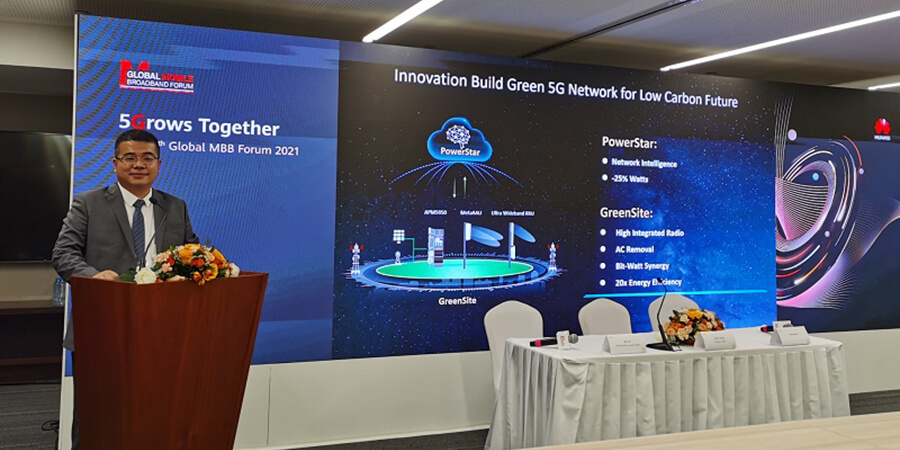At the 2021 Global Mobile Broadband Forum (MBBF), Aaron Jiang, President of Huawei's SRAN Product Line, launched the GreenSite and PowerStar2.0 solutions to help operators build green, low-carbon 5G networks. The GreenSite solution integrates innovative architecture, site construction, and algorithms with leading-edge software and hardware, improving energy efficiency by 20 times. The PowerStar2.0 solution introduces new intelligent energy-saving features to base stations and networks to reduce energy consumption by over 25% through multi-dimensional coordination under typical configurations.
GreenSite solution enables low-carbon sites from three perspectives
Firstly, high-integration radio lowers per-bit power consumption. Huawei's MetaAAU uses ultra-massive antenna arrays to significantly increase antenna gains. Compared with traditional AAU modules, it reduces power consumption by about 30% while providing the same DL coverage. Huawei ultra-wideband RRU uses ultra-wideband power amplifiers, hardware units, and advanced algorithms to integrate multiple single-band devices into a single box with an ultra-compact form factor. This enables more bands to be supported with the same level of power consumption.
Secondly, AC-removed simplified sites effectively reduce carbon emissions. The air conditioning in equipment rooms constitutes 30–40% of a site's total energy consumption. Huawei offers new outdoor cabinet APM5950 to help operators simplify site construction. It allows operators to deploy sites outdoors without using equipment rooms and air conditioners (AC), increasing E2E energy efficiency from 60% to 90% while saving 30% of site energy consumption. It also uses solar power and high-cycle lithium batteries to replace diesel generators, further reducing carbon emissions.
Thirdly, intelligent collaboration and bit-driven watt are new energy-saving trends. The intelligent collaboration between services and site hardware — including power supply, storage, and usage units — enables power supply and consumption efficiency to be adjusted in real time based on traffic load, ensuring that sites operate with optimal overall efficiency. Service-adapted energy usage and smart temperature control help maximize energy supply efficiency.
PowerStar2.0 Doubles Energy Saving with Three Enhancements.
Firstly, it enables fast (Milliseconds) shutdown for 24/7 energy saving. Based on a hardware design that favors maximized energy saving, PowerStar2.0 supports shutdown in milliseconds based on service load, helping extend energy-saving periods from off-peak hours to the entire day. It further adapts deep shutdown to the estimated speeds required for network services to improve energy-saving precision. This helps further prolong energy-saving periods while also meeting user experience requirements.
Secondly, it supports multi-dimensional coordination to enable full-domain energy saving. In PowerStar2.0, power control is further used as the fourth dimension of energy saving beyond the symbol, channel, and carrier levels. The enhancement enables RF modules to transmit less power by increasing scheduling resources, helping ensure user experience and taking network energy saving to new heights.
Thirdly, it enables optimization in seconds for guaranteed performance. PowerStar2.0 introduces base station intelligence to enable fast, refined KPI and energy-saving optimization. When network performance requirements change, base stations and networks implement intelligent prediction and optimization, and accordingly change sleeping policies in seconds. This enables networks to maximize energy saving while also ensuring performance.
"The growing demand for both toB and toC services leads to an explosive increase in data traffic. This highlights the importance of improving energy efficiency in building green low-carbon networks," concluded Aaron Jiang. "Huawei will continue to develop innovative solutions and bring intelligence to base stations to help operators build green, low-carbon 5G networks and achieve the carbon peak and neutrality goals.”








